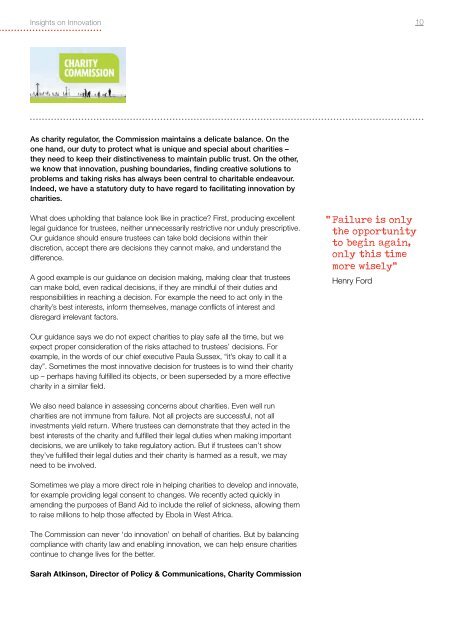O0YQ5
O0YQ5
O0YQ5
You also want an ePaper? Increase the reach of your titles
YUMPU automatically turns print PDFs into web optimized ePapers that Google loves.
Insights on Innovation<br />
10<br />
As charity regulator, the Commission maintains a delicate balance. On the<br />
one hand, our duty to protect what is unique and special about charities –<br />
they need to keep their distinctiveness to maintain public trust. On the other,<br />
we know that innovation, pushing boundaries, finding creative solutions to<br />
problems and taking risks has always been central to charitable endeavour.<br />
Indeed, we have a statutory duty to have regard to facilitating innovation by<br />
charities.<br />
What does upholding that balance look like in practice? First, producing excellent<br />
legal guidance for trustees, neither unnecessarily restrictive nor unduly prescriptive.<br />
Our guidance should ensure trustees can take bold decisions within their<br />
discretion, accept there are decisions they cannot make, and understand the<br />
difference.<br />
A good example is our guidance on decision making, making clear that trustees<br />
can make bold, even radical decisions, if they are mindful of their duties and<br />
responsibilities in reaching a decision. For example the need to act only in the<br />
charity’s best interests, inform themselves, manage conflicts of interest and<br />
disregard irrelevant factors.<br />
" Failure is only<br />
the opportunity<br />
to begin again,<br />
only this time<br />
more wisely"<br />
Henry Ford<br />
Our guidance says we do not expect charities to play safe all the time, but we<br />
expect proper consideration of the risks attached to trustees’ decisions. For<br />
example, in the words of our chief executive Paula Sussex, “it’s okay to call it a<br />
day”. Sometimes the most innovative decision for trustees is to wind their charity<br />
up – perhaps having fulfilled its objects, or been superseded by a more effective<br />
charity in a similar field.<br />
We also need balance in assessing concerns about charities. Even well run<br />
charities are not immune from failure. Not all projects are successful, not all<br />
investments yield return. Where trustees can demonstrate that they acted in the<br />
best interests of the charity and fulfilled their legal duties when making important<br />
decisions, we are unlikely to take regulatory action. But if trustees can’t show<br />
they’ve fulfilled their legal duties and their charity is harmed as a result, we may<br />
need to be involved.<br />
Sometimes we play a more direct role in helping charities to develop and innovate,<br />
for example providing legal consent to changes. We recently acted quickly in<br />
amending the purposes of Band Aid to include the relief of sickness, allowing them<br />
to raise millions to help those affected by Ebola in West Africa.<br />
The Commission can never ‘do innovation’ on behalf of charities. But by balancing<br />
compliance with charity law and enabling innovation, we can help ensure charities<br />
continue to change lives for the better.<br />
Sarah Atkinson, Director of Policy & Communications, Charity Commission


